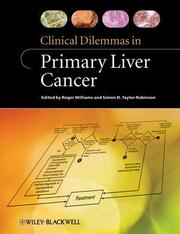Detailansicht
Clinical Dilemmas in Primary Liver Cancer
Clinical Dilemmas
ISBN/EAN: 9780470657973
Umbreit-Nr.: 1266645
Sprache:
Englisch
Umfang: 230 S.
Format in cm:
Einband:
kartoniertes Buch
Erschienen am 23.12.2011
Auflage: 1/2011
- Zusatztext
- Clinical Dilemmas in Liver Cancer follows the successful format of the other books in the Clinical Dilemmas series, with each chapter focused on a specific dilemma, or issue facing doctors in their day-to-day job, and providing them with practical clinical information and help to better assessment and treat their patients - in this case patients suffering from liver cancer, the third commonest cancer in terms of mortality worldwide. Chapters feature up-to-date information on the basic mechanisms, epidemiological risk factors, screening and surveillance strategies, diagnosis and treatment. It is an extremely practical and clinically-orientated book, and as most patients around the world present with advanced disease, a main focus is on the most recent advances allowing early diagnosis and use of locoregional and systemic therapy, surgery, transplantation and combination therapies. Each chapter is authored by an international expert in the relevant area.
- Kurztext
- How do you look after the liver as well as the tumour? Is one scoring system in patient assessment more useful than another? Is microbubble ultrasound an advance in surveillance screening? Clinical Dilemmas in Primary Liver Cancer considers these and other questions in a highly practical, user-friendly format. Edited by Roger Williams and Simon Taylor-Robinson, two of the UK's top hepatologists and leading figures on liver cancer, this concise guide provides evidence-based expert guidance on subjects ranging from epidemiological risk factors and screening and surveillance strategies to diagnosis and treatment. Contributing authors, experts in particular areas in liver cancer treatment, know your daily clinical challenges because they share them. The six major sections of the book cover: * Learning from a worldwide perspective * Influence of tumour characteristics * Complexities of patient assessment and scoring systems * Choice of radiological diagnostic technique * Can treatment be tailored to the patient? * What does the future hold? Recent advances allowing early diagnosis and use of locoregional and systemic therapy, surgery, transplantation, and combination therapy may help to reverse the established pattern of patients presenting with advanced disease, and the authors carefully review these important developments. Clinical Dilemmas in Primary Liver Cancer is essential reading for all those involved in the care of patients with liver cancer, including established and trainee hepatologists and gastroenterologists, transplant surgeons, pathologists, and specialist hepatology nurses.
- Autorenportrait
- InhaltsangabeList of Contributors. Preface. Part 1: Learning from a Worldwide Perspective. 1 Are patterns and prevalence changing? (Hashem B. El-Serag). 2 Why is the tumour different in Africa? (Nimzing G. Ladep). 3 Control by vaccination: Asian and Taiwan experience (Jia-Horng Kao). 4 The view from the UK (Shahid A. Khan, Mireille B. Toledano, Abigail Zabron, Mehtan Ahmed, and Simon D. Taylor-Robinson). 5 The view from the United States (Hitoshi Maruyama and Arun J. Sanyal). 6 New challenges of NAFLD and HIV epidemics (Quentin M. Anstee and Janice Main). Part 2: Influence of Tumour Characteristics. 7 Controversies in Pathology (Tania Roskams). 8 Not to forget the unusual tumour (Bernard C. Portmann). 9 What can be learned from molecular diagnostic techniques and genetic signatures? (Tariq Moatter and Saeed Hamid). Part 3: Complexities of Patient Assessment and Scoring Systems. 10 Looking after the liver as well as the tumour (Roger Williams). 11 Comparative performances of staging systems for hepatocellular cancer: Early HCC considerations (Peter D. Peng, Timothy M. Pawlik). 12 Rival scoring systems: Do they offer more? (Angelo Sangiovanni and Massimo Colombo). 13 Is it possible to detect early lesions effectively? (Ryota Masuzaki and Masao Omata). 14 What is the value of country based surveillance programmes? (Peter Ott). Part 4: Choice of Radiological Diagnostic Technique. 15 Computed tomography or magnetic resonance imaging for the diagnosis of hepatocellular carcinoma (Wladyslaw Gedroyc). 16 Is Microbubble ultrasound useful? (Adrian Lim). 17 Value of PET scanning (Tara Barwick, Imene Zerizer, and Adil Al-Nahhas). Part 5: Can Treatment be Tailored to the Patient? 18 Who could benefit from chemoembolisation? (Gisèle N'Kontchou, Olivier Seror, and Michel Beaugrand). 19 Are drug eluting beads (DEB) worth using? (C. N. Hacking and Pradesh Kumar). 20 What's the future of image-guided radiofrequency ablation for hepatocellular carcinoma? (Riccardo Lencioni). 21 Alternative ablation techniques for hepatocellular carcinoma (John Karani). 22 Justification for Sorafenib and chemotherapy (Philip J. Johnson). 23 When to consider surgery? (Emmanuel Melloul, Mickaël Lesurtel, and Pierre-Alain Clavien). 24 Transplant considerations (Myron Schwartz). Part 6: What Does the Future Hold? 25 Dipstick markers for diagnosis: Feasible or not? (Mohamed I. F. Shariff and Simon D. Taylor-Robinson). 26 Targeted gene therapy for hepatocellular carcinoma (HCC): A reality? (Christopher Binny, Marco Della Peruta, and Amit C. Nathwani). 27 Is immune modulation a possibility? (Tim F. Greten and Firouzeh Korangy). 28 Systemic therapy for hepatocellular carcinoma: Future directions (Daniel H. Palmer, Matthew Cramp).
